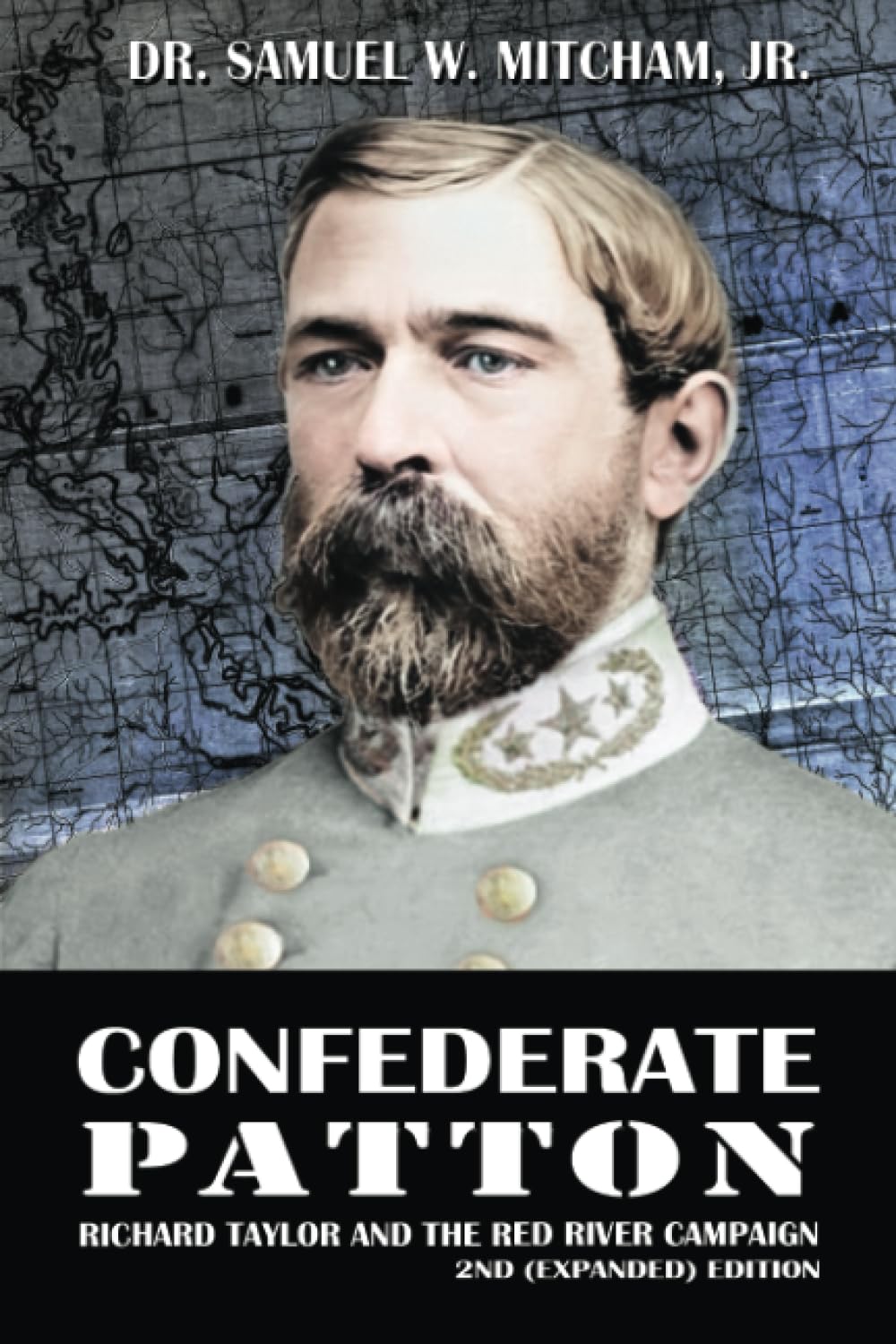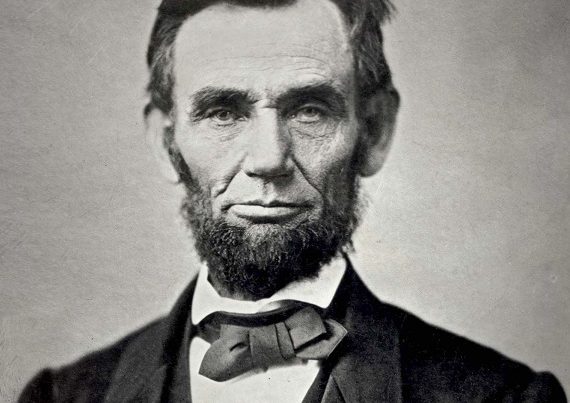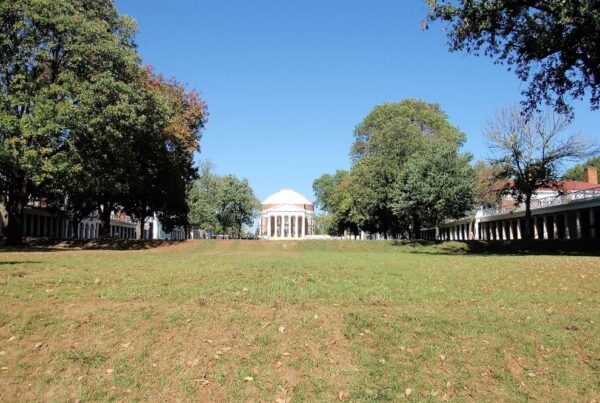A review of Confederate Patton: Richard Taylor and the Red River Campaign, 2nd (Expanded) Edition (Columbia, SC: Shotwell Publishing, 2023), by Dr. Samuel W. Mitcham, Jr.
It is hard to imagine that there is a more thorough or exciting book out there on the Red River Campaign, a/k/a Red River Expedition, that took place March to May, 1864, in the Trans-Mississippi theater during the War Between the States.
Perhaps that is because it is a second and expanded edition. The first edition was published in 2012 as Richard Taylor and the Red River Campaign (Gretna, LA: Pelican Publishing).
The Red River is also called the Red River of the South (better name!) and was once a tributary of the Mississippi River but is now a tributary of the Atchafalaya River. It is so named because it flows with a reddish (sometimes haunting red) color because of passing through red-bed country.
The Red River’s south bank was part of the U.S.-Mexican border from 1821 until the creation of the Republic of Texas in 1836.
Sam Mitcham believes that in 1864, despite the South’s being worn down by the North’s enormous advantages in manpower and resources, the South still could have won its independence through a negotiated peace if it had held Atlanta until after the November elections. Even Republican Lincoln believed he would lose, and if he had, the Democrats had a “‘peace at any price'” plank waiting in their platform.
So, late 1864 is a critical time, rife with opportunity for a man that could think like Alexander the Great, whose words Mitcham chose for an epigraph:
I do not fear any army of lions led by a sheep.
I do fear an army of sheep led by a lion.
Mitcham writes in the Introduction:
Outnumbered 8,800 to 32,000, but led by a lion, the ragged and ill-equipped Confederate Army of Western Louisiana threw itself at the throat of the Union Army of the Gulf, routed it, surrounded it twice, starved it half to death, and chased it for 200 miles, all the way across Louisiana, while simultaneously inflicting heavy losses on the Union Navy’s inland flotilla, which also fled for its life.
You know you can trust a book that says in the first words of the first chapter, “The Civil War (a/k/a the War for Southern Independence) began on April 12, 1861, when Abraham Lincoln successfully provoked Confederate President Jefferson Davis into firing on Fort Sumter,” then Mitcham backs it up with lengthy, irrefutable citation in his first footnote.
Mitcham is right.
Several Northern newspapers confirmed Lincoln’s subterfuge including the Providence (R.I.) Daily Post that wrote, in an editorial entitled “WHY?”, published the day after the commencement of the bombardment of Fort Sumter, April 13, 1861:
We are to have civil war, if at all, because Abraham Lincoln loves a party better than he loves his country. . . . Mr. Lincoln saw an opportunity to inaugurate civil war without appearing in the character of an aggressor.
The New York Herald eight days earlier wrote:
We have no doubt Mr. Lincoln wants [President Davis] to take the initiative in capturing . . . forts in its waters, for it would give him the opportunity of throwing [to the South] the responsibility of commencing hostilities.
Mitcham is spot on, but you would expect that from an historian who has written 40 books and more than 100 articles “which have been translated into German, Italian, Polish, Chinese, Russian, Spanish, Japanese, and other languages.” He is the winner of the John Esten Cooke Literary Prize and holds the Jefferson Davis Gold Medal for excellence in the research and writing of Southern history, as the back cover states.
Mitcham is also commander of Camp 1714, SCV, in West Monroe, Louisiana, and is Heritage Operations Historian of the Sons of Confederate Veterans.
The 385 page, 6 x 9″ softcover book has Appendices, maps, tables, photographs, drawing and other illustrations. There is an extensive bibliography, and the 584 footnotes are often fat with detail. I would always rather see footnotes than endnotes because who wants to flip to the back of a book to read important detail! Better to look down, read it on the same page, and move on in an exciting read.
The Appendices contain the Order of Battle for the Army of Western Louisiana, CSA, commanded by Major General Richard Taylor; and the Army of the Gulf, USA, commanded by Major General Nathaniel P. Banks, both dated April 8, 1864.
Mitcham gives much on the background of the Campaign including the economic issues such as the Northern need for Southern cotton that was much of the North’s motivation.
Mitcham’s extensive knowledge of history is on full display such as on page 20:
During the Civil War, 191,000 African-Americans served in the Union Army. By the end, 12% of the 1,000,000 men in the United States Army were African-American. . . .
It will probably come as a surprise to many, and some will consider it “politically incorrect” to say so, but there was another side to this coin: tens of thousands of African-Americans fought for the Confederacy as well. Private James G. Bates of the 13th Iowa Volunteers was certainly surprised when a black Confederate sniper shot some of his comrades. He wrote to his father: “I can assure you of a certainty, that the rebels have negro soldiers in their army. One of their best sharp shooters, and the boldest of them all here is a negro … . You can see him plain enough with the naked eye.” In fact, the first Union officer killed in action in the Civil War was Major Theodore Winthrop, the son of a prominent New England abolitionist family. He was shot down in the Battle of Big Bethel by a black Confederate sniper.
To compare the number of black Union soldiers with black Confederate soldiers, Mitcham writes on page 23:
So how many African-Americans fought for the South? . . . Estimates of the number of African American combat soldiers vary from 65,000 to 100,000, with 80,000 to 96,000 being the best estimates, in my view, based on the report to general Lee. Ed Kennedy, a historian, a graduate of Command and General Staff College and a retired colonel, seems to agree. He estimated that 7% to 8% of the Confederate forces were African-American. . . . Incidentally, the black Rebels were much better led than their Union counterparts because they had the same officers as the white Rebels [and not Yankee flunkies that could not make it in the white Union Army and usually ended up commanding United States Colored Troops (USCT) units].
All of the figures above are separately cited and documented in the book.
There is much biographical information and it is detailed, especially on the leaders.
All of the background and strategy is presented in separate chapters, with battles having their own chapters such as:
Chapter V, Up the River and Through the Woods: The Battle of Henderson Hill
Chapter VI, The Battle of Mansfield
Chapter VII, The Battle of Pleasant Hill
Chapter IX, The Camden Expedition
Chapter X, Monett’s Ferry and the Retreat to Alexandria
Chapter XII, Across the Atchafalaya
The other chapters fill-in detail, and there is an “Epilogue and Postscript: What Happened to the Men of the Red River Expedition”, that sums things up and provides a very satisfying narrative about Taylor, Banks and warriors on both sides after the war, until they died.
Just to give you a taste of this book, here is a little from Chapter VI, The Battle of Mansfield, page 184:
By now, the Union artillery was trying to escape with their guns, but they never really had a chance to accomplish this. The forest was too thick. Artillerymen abandoned their pieces, hopped onto the backs of their horses, and headed for the rear. Even the few guns that got out of the forest found escape impossible because the cavalry wagon train blocked the only road.
General Taylor, still perched on his horse, watched all this and calmly sucked on his cigar. Seeing that the Union line was coming unraveled, he summoned his dispatch riders and initiated phase two of his plan. He ordered the Texas Division on his right to drive forward in echelon to the left to hit the Yankee line like rapidly breaking waves.
John Walker was certainly ready. Like Dick Taylor, the Texas commander was a picture of serenity. One of his men recalled: “. . . about 600 yards from the enemy’s position, we beheld General Walker, mounted on his iron-gray horse, with his field-glass to his eye, taking observations of the enemy’s position. His actions and features were a study for the closest scrutinizer of physiognomy. Not a quiver on his face–not the movement of a muscle, to betray anxiety or emotion, notwithstanding the shower of balls whizzing around him.”
Mitcham has organized a lot of material, added fascinating photographs and maps, and used profuse first hand quotations and observations that put you on the battlefield with the men. He gives you all the backstory from the perspective of a masterful historian, one of the best, and you have the satisfaction of knowing how the men spent the rest of their lives.
This is a wonderful book on so much more than just the Red River Campaign. It should be in everybody’s library.







Oh, that Dr. Mitcham could be heard in the national “media” as opposed to the historian frauds such as Victor Davis Hanson, Mark Levin ad nauseum…
Oh, that Dr. Mitcham could be heard in the national “media” as opposed to the historian frauds such as Victor Davis Hanson, Mark Levin ad nauseum…
Taylor was the man. In fact, since people here love to comment on old songs, my favorite verse in HOUSE OF THE RISING SUN mentions the great General.
THERE IS A HOUSE IN NEW ORLEANS…THEY CALL THE RISING SUN…AND IT’S BEEN THE RUIN OF MANY A POOR BOY…AND GOD, I KNOW, I’M ONE.
MY MOTHER, SHE WAS A TAYLOR…SHOWN HERE WITH ROBERT E LEE…MY DADDY WAS SHOT DOWN ON BOURBON STREET, BY ONE OF BANK’S DAMN YANKEES…
About the union blacks…
Go watch Ukraine round up soldiers and imagine the yankees doing the same in the border States and union-controlled territory to blacks under their protection. The truth has already come out (officially now, that the internet cannot be controlled)…but the yankees pretend they’re the ones revealing what was “accidentally” hidden.
There are thousands of first-hand accounts yet to be discovered by our yankee brethren describing how slaves and former slaves were forced into their armies BY THE TENS OF THOUSANDS. It is the last lie to fall in the battle for the narrative. Of course, we won’t even go into those who were bribed to substitute for a rich man to the tune of 300 dollars PER DRAFT ROUND. 300 bucks was some serious money back in them days…300 DOLLARS IS WHAT THE YANKEES PAID TO FREE 3000 SLAVES IN WASHINGTON, DC IN APRIL 1862. Begging the question, WHY DIDN’T THEY JUST BUY ALL THE SLAVES? Things that make you go…hmmmmm.
THE SLAVE NARRATIVES were hidden…and now found easily on the web. UP FROM SLAVERY was hidden…blacks no longer name schools for BT Washington…after all, he said “blacks loved their masters”. Frederick Douglass said slavery was so horrible…”slaves were given weeks off at Christmas AND SUPPLIED WITH ALCOHOL (AND TURKEYS, HAMS, GREENS, CAKES AND PIES) IN ORDER TO KEEP THEM HAPPY AND ENSLAVED”. This is the same Frederick Douglass who didn’t want women to vote and claimed to HAVE WHIPPED MY MASTER IN A FISTFIGHT…even though Douglass claimed slavery was a horror unimaginable…despite the same Douglass complaining about the “thousands of blacks fighting in Confederate uniform”…which is the real reason we now see yankee authors rushing to pretend they discovered some SECRET that could have previously only been found in decades-old SCV magazine articles.
IF YOU WANT TO KNOW HOW HORRIBLE SLAVERY WAS…CONSIDER TENS OF THOUSANDS OF YANKEES THROWING THEIR WEAPONS ON THE GROUND AND RUNNING FROM SCREAMING REBELS WHILE TENS OF THOUSANDS OF FREE BLACKS AND SLAVES REFUSED TO PICK UP THESE SAME WEAPONS AND TURN THEM ON THEIR NEIGHBORS AND MASTERS.
Soon, some yankee will discover there were only 250,000 free blacks in the South and of these 250k, 125k were women which leaves 125k men…of which, one third were too young and one third too old to fight, leaving…around 40,000 to 50,000 free men…and of these free men, I WILL GUARANTEE YOU AT LEAST 10 PERCENT WERE VOLUNTEERS TO FIGHT YANKEES. You ask me how I know this…I listened to the men around the campfire growing up.
Soon, some yankee will discover the 14th Amendment was used to disenfranchise WHITE, SOUTHERN MALES. Just imagine what an uproar that will create. I am sure some yankee will get rich documenting this “accidental” result of the forced ratification of a US Constitutional Amendment.
This is a wonderful era to experience…it’s going to revolutionize the world as the printing press did…try burning the internet…can’t be done…just like the yankees couldn’t burn all the copies of HARPER’S WEEKLY, 10 JAN 1863, REBEL NEGRO PICKETS…I remember seeing it for the first time, almost 50 years ago in the OLD COURTHOUSE MUSEUM in Vicksburg, MS. The curator was following this curious boy around…hoping he was smart enough to understand…when the boy stopped in front of the display of the mentioned newspaper…and stared…and stared…the curator asked…CAN YOU HANDLE THE TRUTH?
Damn yankees can’t handle the truth…but they will pretend they “discovered” it and try to make a dime off correcting their own lies.
I want to shake your hand. Russell Person CA Div SCV Historian
Yes sir. Maybe in Charles Town, next year. I am in SCV Camp 1319.
A compelling review of CONFEDERATE PATTON: Richard Taylor and the Red River Campaign. His reputation precedes General Taylor for an eastern-centric amateur historian of the Confederate War. His great service with Stonewall Jackson in 1862 rendered it impossible for Jackson not to recommend him for promotion, probably knowing Taylor would be sent to the western theater
There is a probably unintentional tangent of interest in the title of author Dr. Samuel W. Mitcham, Jr’s book, one that’s not necessary to his study of General Taylor. It’s certainly well known that the grandfather of General George S. Patton, Col. George S. Patton, served with distinction in the Confederate army. Twice before wounded, Col. Patton was mortally wounded at 3rd Winchester in 1864 while serving under Jubal Early. Promotion to brigadier-general had been approved but he died before it was received. Col. George S. Patton had six brothers serve the cause as well – so much for “brother against brother”. One brother fought at New Market as part of the VMI corps of cadets, another was mortally wounded in Pickett’s Charge.
I would question whoever decided to title the book “Confederate Patton.” Did Patton ever face the odds that Taylor did in the Red River campaign? Did Patton ever fight against a force superior to his? Taylor’s achievement seems several orders of magnitude beyond anything Patton was ever called on to do.
I’m glad Shelby Foote had decided to put his notes in the rear of his “The Civil War” books. I just wanted to read his narrative without pausing from the narrative to look at a note. I could look at any notes when I was done reading. I know he got a lot of flack for not inserting the notes along with the narrative, but I think it was a good decision.